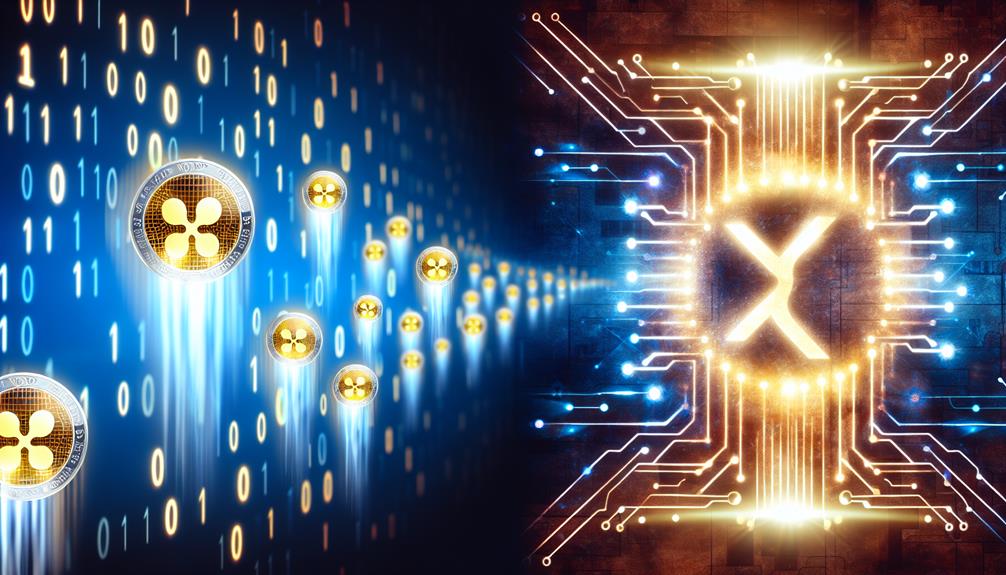It's a curious coincidence that many people think of XRP and Ripple as interchangeable terms, much like how folks sometimes confuse a brand with its product. You might find yourself wondering why this confusion persists, especially given the pivotal role Ripple Labs plays in the cryptocurrency landscape. The relationship between the digital asset and its parent company is intricate and often misunderstood. Exploring this dynamic can shed light on the reasons behind the terminology and its implications for users and investors alike.
Understanding XRP and Ripple

Frequently, people confuse XRP with Ripple, but understanding the distinction between the two is vital. Ripple is the company that developed the payment protocol and network, while XRP is the digital asset utilized within that network. This differentiation is important, especially when evaluating XRP valuation, as it often gets influenced by Ripple's strategic partnerships and technology advancements.
When you analyze XRP's valuation, you need to take into account how it functions as a bridge currency in Ripple's ecosystem. Ripple's partnerships with financial institutions, such as Santander and American Express, greatly enhance its credibility and adoption. These collaborations aim to streamline cross-border payments, and they position XRP as a viable liquidity tool, which directly affects its market value.
Moreover, Ripple's technology is designed to facilitate real-time transactions, which can potentially lower costs and improve efficiency for banks and financial entities. The success of these partnerships can lead to increased demand for XRP, thereby impacting its valuation positively. You should also recognize that regulatory developments surrounding Ripple can create volatility in XRP's market price, making the asset's performance a reflection of both technological adoption and the broader regulatory landscape.
The Origin of XRP
To grasp the full context of XRP, it's important to look back at its origins. XRP was created by Ripple Labs in 2012, aimed at revolutionizing the way financial institutions conduct cross-border transactions. This cryptocurrency was developed to address the limitations of traditional banking systems, which can be slow and costly. By leveraging a decentralized network, Ripple sought to enhance the efficiency and speed of money transfers, a vision that would ultimately shape XRP history.
Initially, Ripple's branding was tightly interwoven with the technology behind XRP. The company positioned itself as a bridge currency, facilitating instant and low-cost international payments. This strategic branding helped to establish XRP as a significant player in the crypto space, although it also led to some confusion among users who often equated XRP with Ripple itself. This conflation is evident in the way many still refer to XRP as "Ripple," despite the distinct functionalities of the cryptocurrency and the technology underpinning it.
As XRP gained traction, its utility in financial transactions became increasingly recognized. The token's design allows for rapid settlement times—typically under five seconds—making it an attractive option for banks and payment providers. This unique feature, coupled with Ripple's aggressive marketing and partnerships, has positioned XRP as a leader in the digital currency landscape. Understanding the origins of XRP gives you insight into its current role and the implications of Ripple's branding strategies on public perception.
Ripple's Technology Explained

While many associate XRP primarily with its role as a digital currency, understanding Ripple's underlying technology reveals the true innovation at play. Ripple's network is designed to facilitate cross-border payments efficiently, leveraging a unique consensus mechanism that enables transaction speeds far superior to traditional banking systems. This technology allows for near-instantaneous transfers, addressing the pressing need for liquidity provision in global markets.
In the domain of remittance services, Ripple excels by minimizing transaction costs and time delays, which are often plagued by market volatility. By integrating blockchain technology, Ripple enhances the reliability and transparency of cross-border transactions, guaranteeing that users can send funds with confidence. This integration also plays a critical role in promoting financial inclusion, particularly for those in unbanked regions.
Additionally, Ripple's focus on scalability solutions positions it as a robust alternative to conventional financial services. As decentralized finance (DeFi) continues to grow, Ripple's architecture can accommodate increasing transaction volumes without compromising performance. The platform's ability to handle vast amounts of transactions guarantees that it remains a viable option for businesses and individuals alike.
Ultimately, Ripple's innovative technology not only streamlines the process of cross-border payments but also addresses broader issues within the financial ecosystem, paving the way for a more inclusive and efficient future. By harnessing these advancements, Ripple stands at the forefront of the evolving landscape of digital finance.
The Role of Ripple Labs
Ripple Labs plays an essential role in the development and promotion of the XRP ecosystem, establishing itself as a pioneer in blockchain technology. Understanding the company's history and its innovative solutions sheds light on how it shaped the Ripple network's architecture and functionality. By examining these aspects, you can appreciate the synergy between Ripple Labs and the XRP currency.
Company Overview and History
The evolution of digital currencies has been greatly shaped by influential companies, and Ripple Labs stands out as a vital player in this landscape. Founded in 2012, Ripple's founding vision centered on creating a more efficient global payments system. Its corporate evolution has been marked by strategic partnerships with financial institutions, enhancing its market positioning against competitors like SWIFT.
Leadership changes over the years have influenced Ripple's direction and adaptability, driving innovation within its product offerings. Significantly, the launch of the XRP Ledger and its native currency, XRP, were essential financial milestones that positioned Ripple as a significant player in the blockchain space.
The competitive landscape remains challenging, yet Ripple's industry impact is undeniable, having facilitated cross-border transactions for multiple banks and payment providers. As the company continues to navigate regulatory challenges and market demands, its future prospects hinge on further technological advancements and partnership expansions.
Technology Behind Ripple Network
At its core, the Ripple network is built on a unique architecture that enables secure and efficient cross-border transactions. Central to this architecture is its consensus algorithm, which allows for transaction validation without the need for mining, resulting in remarkable transaction speed. This efficiency is essential for financial institutions seeking innovative payment solutions that enhance liquidity management and streamline cross-border payments.
Ripple's approach to decentralized finance is significant, as it fosters blockchain interoperability, allowing various financial systems to communicate seamlessly. By facilitating the use of XRP as a digital asset, Ripple enhances market adoption of its technology, providing a robust framework for real-time settlement of international transactions.
Moreover, Ripple Labs plays a pivotal role in driving the development of this network, collaborating with banks and payment providers to implement solutions that meet the evolving needs of the financial sector. As these institutions increasingly recognize the advantages of Ripple's technology, including lower costs and faster processing times, the potential for widespread integration grows, positioning Ripple as a leader in the future of finance.
The Relationship Between XRP and Ripple

Understanding the relationship between XRP and Ripple is essential for grasping the dynamics of digital finance. Many people encounter Ripple confusion due to the intertwined branding of XRP and Ripple Labs. Fundamentally, XRP is a digital asset designed to facilitate cross-border transactions, while Ripple is the company that created the underlying technology and payment solutions that utilize XRP. This distinction is significant for you to appreciate the token utility of XRP within the financial ecosystem.
XRP serves as a bridge currency in Ripple's network, enabling quicker settlement times and lower fees compared to traditional systems. However, despite its potential, XRP faces adoption challenges, particularly in a market perception dominated by skepticism and regulatory scrutiny. The dual identity of XRP—as both a currency and a tool for Ripple's technology—often complicates investor understanding and affects its market performance.
Moreover, XRP's branding plays a significant role in its recognition as a leading digital asset. While Ripple focuses on partnerships with financial institutions to enhance their payment solutions, XRP's value proposition lies in its ability to provide liquidity and efficiency in transactions. This symbiotic relationship can lead to broader adoption of both the token and the technology it supports. As the digital finance landscape evolves, recognizing these nuances will help you navigate the complexities of cryptocurrencies and their role in modern finance.
Common Misconceptions About XRP
When discussing XRP, many people confuse it with the Ripple network, assuming they're one and the same. It's vital to differentiate between XRP as a digital asset and the underlying technology that facilitates transactions. Additionally, regulatory misunderstandings often cloud perceptions, making it essential to clarify what XRP truly represents in the broader cryptocurrency landscape.
XRP Vs. Ripple Network
One common misconception is that XRP and the Ripple network are interchangeable terms, but they serve distinct purposes within the broader ecosystem. XRP is a digital asset primarily used as a bridge currency, facilitating cross-border transactions by providing liquidity. It's designed to enhance XRP adoption by making international payments faster and cheaper compared to traditional systems.
On the other hand, the Ripple network is the underlying technology and protocol that enables the transfer of value using XRP and other fiat currencies. It focuses on improving Ripple performance by ensuring secure, efficient, and reliable transactions among financial institutions.
Understanding this distinction is essential for grasping the potential of both XRP and the Ripple network. While XRP's role as a currency is significant for driving adoption, the Ripple network's technology is what makes it possible for banks and payment providers to execute those transactions seamlessly.
Currency Vs. Technology
The distinction between currency and technology in the context of XRP often leads to confusion among both new and seasoned investors. Many perceive XRP solely as a digital asset for transactions, but it's important to recognize its role as a part of a broader technological framework. XRP operates within a sophisticated ledger system that employs blockchain technology to enhance transaction efficiency. This is significant for payment systems, especially in remittance solutions where speed and cost-effectiveness are fundamental.
XRP facilitates banking integration, allowing traditional financial institutions to adopt innovative solutions that align with the evolving landscape of decentralized finance (DeFi). While XRP is a cryptocurrency, its primary function extends beyond being just a currency; it's a tool for financial innovation. This duality is essential for understanding how cryptocurrency adoption can revolutionize traditional payment methods.
Investors should appreciate that XRP's value stems not only from its market performance but also from its underlying technology that supports seamless transactions across borders. By distinguishing between currency and technology, you can gain a clearer perspective on XRP's potential impact on the future of finance.
Regulatory Misunderstandings Explained
Misunderstandings surrounding XRP's regulatory status often stem from conflating its technological function with traditional securities classifications. This confusion contributes to significant regulatory challenges and compliance issues that XRP faces. Unlike typical securities, XRP functions primarily as a digital asset facilitating cross-border transactions, yet market perceptions often frame it through a lens of investment speculation.
The legal implications of XRP's classification are profound. When regulators scrutinize XRP under existing financial regulations, they may inadvertently misapply industry standards that are suited for other asset types. This misalignment raises investor concerns about the asset's legitimacy and future viability.
Government scrutiny has heightened since the SEC's involvement, which has led many to question whether XRP is a security or a utility. These uncertainties create a ripple effect, influencing market behaviors and investment decisions. As a result, potential investors may hesitate, fearing compliance issues that could arise from regulatory actions.
To navigate this landscape, it's essential to understand that XRP's utility as a payment protocol is distinct from the investment narrative often associated with it. Recognizing this distinction can help clarify the ongoing debates surrounding XRP's regulatory positioning in the financial ecosystem.
Frequently Asked Questions
Can XRP Be Used for Online Purchases?
XRP can indeed be used for online purchases, especially as XRP adoption grows. With various payment integrations and more online merchants accepting it, you'll find cryptocurrency wallets supporting XRP increasingly convenient for transactions.
Is XRP Available on All Cryptocurrency Exchanges?
XRP isn't available on all cryptocurrency exchanges, which can impact its liquidity and adoption. You'll need to research specific platforms to guarantee they support XRP, as availability varies considerably across different trading venues.
How Does XRP Compare to Bitcoin?
XRP processes transactions in about four seconds, compared to Bitcoin's ten minutes. While XRP's advantages include faster speed and lower fees, its limitations involve regulatory scrutiny and a centralized structure, raising concerns about decentralization compared to Bitcoin.
Can I Mine XRP Like Other Cryptocurrencies?
You can't mine XRP like other cryptocurrencies. XRP mining isn't possible since it operates on the Ripple network, which uses a consensus protocol. Instead, XRP is pre-mined, limiting supply and promoting transaction efficiency.
What Is the Current Market Price of Xrp?
You might think XRP's market price fluctuates wildly, but it's driven by XRP adoption and Ripple partnerships. Keeping an eye on these factors can provide better insights into its current market performance and future potential.
Conclusion
In summary, while XRP and Ripple are often intertwined in conversation, it's important to recognize their distinct identities. XRP serves as a digital bridge within Ripple's innovative framework, yet the line between them is frequently blurred. Misunderstandings abound, but grasping their unique roles can illuminate the future of cross-border transactions. As you navigate this intricate landscape, remember that clarity in terminology can foster more informed decisions in the ever-evolving world of cryptocurrency.
